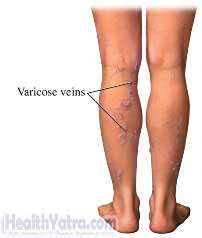Definition
This procedure involves the removal or destruction of enlarged veins in the leg that are just under the skin.
There are different methods to remove veins, such as:
- Chemical ablation (called sclerotherapy)
- Radiofrequency (heat energy) or laser ablation
- Vein stripping
- Surgery (called phlebectomy)

Reasons for Procedure
Veins have one-way valves to channel blood back to the heart. Varicose veins develop when the valves of the veins become damaged. This causes blood to pool in the veins, enlarging them and often making the veins just beneath the skin visible. The skin can also turn dark purple or brown because of increased pressure.
Treatment may be done for cosmetic and health reasons. In some cases, the areas of discolored skin may break down and form open sores (called stasis ulcers). Clots can also form in the pooled blood. When the valves are functioning poorly, your leg may burn, ache, or throb.
Treatment for this condition can involve either destroying or removing the damaged veins.
Possible Complications
Complications are rare, but no procedure is completely free of risk. If you are planning to have treatment for varicose veins, your doctor will review a list of possible complications, which may include:
- Recurrence of varicose veins
- Bleeding
- Infection
- Skin discoloration at the surgical site (usually goes away within a few weeks)
- Deep vein thrombosis (blood clot)
Factors that may increase the risk of complications include:
- Smoking
What to Expect
Prior to Procedure
Your doctor will:
- Evaluate your deep and superficial vein systems and decide which veins will be removed
- Do an ultrasound—a test that uses sound waves to examine the veins in your legs
Leading up to the procedure, you may be advised to:
- Talk to your doctor about your medicines. You may be asked to stop taking some medicines up to one week before the procedure, like:
- Anti-inflammatory drugs (eg, aspirin )
- Blood thinners, like clopidogrel (Plavix) or warfarin (Coumadin)
- Wear special support stockings.
- If you have a stasis ulcer, wear Unna boots. This is a type of cast that will aid in healing the ulcer.
Anesthesia
The anesthesia depends on the type of procedure that you are having, for example:
- Sclerotherapy—no anesthesia is needed
- Radiofrequency, laser ablation, or surgery:
- General anesthesia —blocks pain and keeps you asleep through the surgery
- Epidural anesthesia —numbs the area from the chest down to the legs; given as an injection in your back
- Stripping—general or epidural anesthesia
Description of the Procedure
Sclerotherapy
With this procedure, the doctor will inject a chemical into each of the damaged veins. This chemical will scar the vein so that it will no longer be able to carry blood. This will be a short, simple office procedure.
Radiofrequency or Laser Ablation
This is done on one of the largest superficial veins, called the greater saphenous vein. The doctor will view the vein using an ultrasound. She will then puncture the vein near the knee. A catheter (small tube) will be threaded up to the groin. The space between the vein and the skin will be filled with a special solution. This solution will provide local anesthesia. The catheter will then be attached to a radiofrequency generator or a laser. Heat or light energy will seal the vein closed so that there is no longer any backflow of blood.
Vein Stripping
The doctor will remove the veins by threading a long wire into them. Each vein will be tied to this wire and then stripped out. This will leave the smaller side branches broken off and in place. This procedure is usually not used on the saphenous vein.
Phlebectomy
This surgery is used to remove larger veins that cannot be injected. The doctor will make many small incisions to access each varicose vein. The vein will either be tied off or removed.
After the Procedure
If the doctor does vein stripping, you will have many loose vein ends in your leg. Your leg will be tightly wrapped. This it to prevent blood from leaking out of the veins.
How Long Will It Take?
- Sclerotherapy—short office visit
- Radiofrequency or laser ablation—1 hour
- Vein stripping—1-1½ hours
- Phlebectomy—2-4 hours
Will It Hurt?
You will have pain and discomfort with the procedure. Stripping is more painful. Ask your doctor about pain medicine.
Post-procedure Care
When you return home, do the following to help ensure a smooth recovery:
- If you had vein stripping, keep your legs elevated while you are resting. This will help to minimize pressure on your veins.
- If you had sclerotherapy or ablation, resume normal activity within a few hours.
- Wear an elastic bandage (eg, ACE bandage) for the first 24-48 hours, or as instructed by your doctor.
- Be sure to follow your doctor’s instructions. You may need to have another ultrasound done.
Call Your Doctor
After arriving home, contact your doctor if any of the following occurs:
- Signs of infection, including fever and chills
- Redness, swelling, increasing pain, excessive bleeding, or any discharge from the incision site
- Pain that you cannot control with the medicines you have been given
- Pain, burning, urgency or frequency of urination, or persistent bleeding in the urine
- Cough, shortness of breath, or chest pain
- Leg swelling
In case of an emergency, call for medical help right away.
